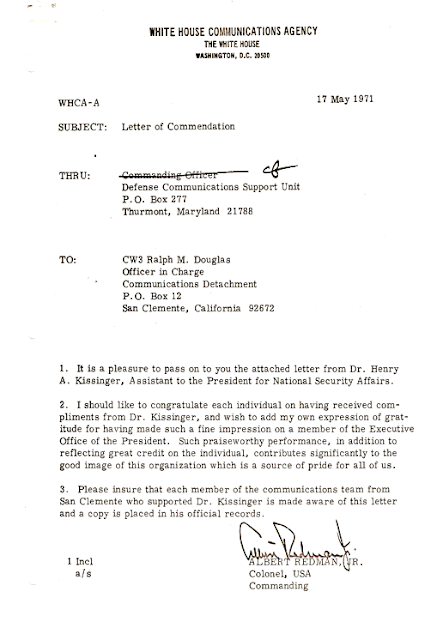PEF Microwave Network |
 | White House Communication Agency's Microwave Network
|
|
| Type of Activity | Private Voice and Data Communications Network |
Location |
Location | PA,MD,WV,VA, DC,USA |
Range | Appalachian Mountains |
Coordinates | +39.648333N -77.466667 W |
The microwave network was designed to provide reliable communications for the President of the United States. This network was also designed to act as relocation facilities and was designed to withstand a nuclear attack. During national emergencies the President would be able to communicate through these facilities and address the American people.
Each microwave route in this network consisted of three systems that could carry voice, video and secure voice/teletype.
.jpg) |
A typical line-up three transmitters, video patch panels and three receivers (front view)
|
.jpg) |
A typical line-up three transmitters, video patch panels and three receivers (rear view)
|
System #1 was dedicated to voice. A Raytheon KTR 1000A microwave RF system carried AN/TCC-13 voice multiplexing equipment to all locations in the network. Every facility in the network had a working communications center capable of providing encrypted TTY utilizing KW-7 and KW-26 transmitters/receivers providing 100 wpm secure teletype on the voice system.
System #2 was used for video. Cactus was equipped with an RCA video switcher and was capable of producing live broadcast video. The emergency broadcast system could also be accessed through Crystal at Mt. Weather.
System #3 was the spare route.
.jpg) |
| TCC-13 24 channel Multiplexer, audio and TTY DC patch panels (front view) |
.jpg) |
TCC-13 24 channel Multiplexer, audio and TTY DC patch panels (rear view)
|
The following facilities were in the Presidential Emergency Network that was operated by the White house Communications Agency. All terminals in the network had manned switchboards to handle voice traffic and also had manned communication centers that handled secure voice and all TTY traffic. The relays in the network were through points with a few drop and insert voice channels. All relays were equipped with a communications center that would become active in the event that an emergency was declared.
Site 1 Cactus (Camp David, Thurmont, Md.) Terminal: Cactus contained a fully equipped, switchboard, and communications center with secure telephone and TTY. In Emergency situations live Presidential addresses could be broadcast over these systems. Cactus had direct shots to Cadre, Cartwheel (thru a microwave RF relay in Damascus Md.), Corkscrew and Cannonball. Cactus could also be used as a relocation site with a fully functional underground Shelter.
Site 2 Cannonball (Mercersburg, Pa) Relay: Cannonball was a relay in the Cactus to Crystal microwave route. Cannonball had direct shots to Cactus, Cowpuncher and Corkscrew. There was also a standby communications center equipped with secure TTY that could be activated if an emergency existed. A buried cable connected Cannonball to the AT&T site at Hearthstone Mountain where traffic could be routed into their underground facilities.
Site 3 Cowpuncher (Martinsburg, WV) Relay: Cowpuncher was a relay in the Cactus to Crystal microwave route. Cowpuncher had direct shots to Cannonball and the Crystal west tower. There was also a standby communications center equipped with secure TTY that could be activated if an emergency existed.
Site 4 Cartwheel (Washington DC) Terminal: Cartwheel had three systems each to Cactus (thru a microwave RF relay in Damascus Md.), Corkscrew, and Crystal. Cartwheel also had a fully operational switchboard and communications center with secure telephone and secure TTY. There was a microwave route from Cactus to Cartwheel, and because there was no line of site, Site D in Damascus was used as an RF relay. There were also one or two microwave systems to Crown. Since there was no line of site to the EOB or the White House, a passive dish was installed on the real water tower at Tinley Park, which was a hundred yards or so from Cartwheel, and the routes terminated in the EOB. Cartwheel was also directly connected to The White House by AT&T cable routes.
Site 5 Crystal (Mt. Weather, VA) Terminal: Crystal had two towers that were built substantially underground, only the top two antenna decks were above ground. The west tower had a direct shot to Cowpuncher and the east tower had a direct shot to Cartwheel. The towers were physically connected by tunnels and accessed through the Mt. Weather facility. Crystal interfaced with Mt Weather‘s underground facility and contained a fully operational switchboard, communications center with secure telephone and secure TTY. Crystal also interfaced with The Emergency Broadcast System at Mount Weather which was capable of live broadcast video and audio over the network
Site 6 Cadre/Creed (Site R. Blue Ridge Summit, Pa) Terminal: Cadre was located within Site R the Pentagon’s underground facility and contained a fully operational switchboard and communications center with secure telephone and TTY. Creed tower was a separate facility located about a mile from Cadre which was connected to Creed by cable and coax. Creed Tower had direct microwave routes to Cactus. The tower was substantially underground, only the two antenna decks were above ground.
Site 7 Corkscrew (Boonsboro Md.) Relay: Corkscrew was a relay location that had direct shots to Cactus, Cannonball, and Cartwheel. There was also a standby communications center equipped with secure TTY. Corkscrew could also be used as a relocation site with a fully functional underground Bunker.
Crown: The White House was the final destination of all the traffic generated from the PEF’s over the microwave network and terminated on the WHCA operated the Signal switchboard and communications center.
.jpg)
.jpg)
.jpg)
.jpg)




















